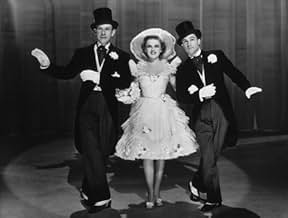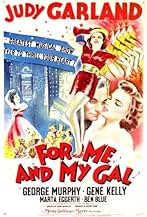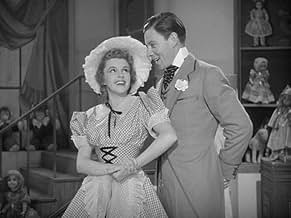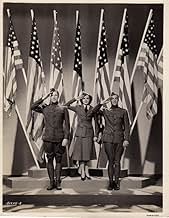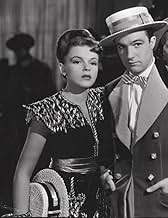NOTE IMDb
7,0/10
4,1 k
MA NOTE
Ajouter une intrigue dans votre langueTwo vaudeville performers fall in love, but find their relationship tested by the arrival of WWI.Two vaudeville performers fall in love, but find their relationship tested by the arrival of WWI.Two vaudeville performers fall in love, but find their relationship tested by the arrival of WWI.
- Réalisation
- Scénario
- Casting principal
- Nommé pour 1 Oscar
- 4 victoires et 1 nomination au total
Mártha Eggerth
- Eve Minard
- (as Marta Eggerth)
Stephen McNally
- Mr. Waring
- (as Horace McNally)
Ernie Alexander
- Theater Workman with Big Die
- (non crédité)
Hooper Atchley
- Assistant Stage Manager
- (non crédité)
Walter Baldwin
- Bill
- (non crédité)
Gurney Bell
- Member - Sportsmen Quartet
- (non crédité)
Herman Boden
- Soldier
- (non crédité)
John Breen
- Soldier
- (non crédité)
Ken Darby
- Member - The King's Men
- (non crédité)
George Davis
- France Taxi Driver
- (non crédité)
Bill Days
- Member - Sportsmen Quartet
- (non crédité)
John Dilson
- Lou
- (non crédité)
Jon Dodson
- Member - The King's Men
- (non crédité)
Lester Dorr
- Stage Manager
- (non crédité)
Avis à la une
I thought Judy Garland gave an Oscar worthy performance in this movie. As for Gene Kelly, it was hard to believe that this was his movie debut, his acting made it seem as if he'd been around Hollywood for years. And oh, that musical score, remeniscent of some film scores by Irving Berlin. Not just your ordinary musical, this one has a fine story that fits in with the time of World War One. The title song as done by Garland & Kelly is a classical show-stopper. For sentimentalists, like my wife and I, there are a few scenes that tug at the heart strings, and provide for some misty eyes.
Gene Kelly makes his smashing screen debut in For me and my gal. That alone should make it a must see. This movie was a delight for numerous reasons. First, I like the fact that this movie was a musical/drama. So, we were able to get a full dose of the manifold talents of Gene Kelly and Judy Garland. Second, the chemistry that Judy and Gene had in this movie was exceptional. The scene in which they are singing the title song is riveting. George Murphy was solid in his role as the amiable friend and colleague, who was a good example of selflessness.
This movie is not as renowned as other Garland classics such as the wizard of Oz and Meet me in St. Louis. However, I think this was her most endearing role. She was beautiful, sweet and vivacious in this movie. I can watch this movie repeatedly, and so should everyone else.
This movie is not as renowned as other Garland classics such as the wizard of Oz and Meet me in St. Louis. However, I think this was her most endearing role. She was beautiful, sweet and vivacious in this movie. I can watch this movie repeatedly, and so should everyone else.
This was Gene Kelly's first foray into film, thanks to Judy Garland. Judy herself is only three years beyond "The Wizard of Oz" and at the top of her talents. Their pairing alone makes this a film worth seeing. Now, when we hear their voices harmonizing---especially in the title song---it feels iconic.
This is really two films joined together. The first part is the story of vaudeville, and an opening dedication page says that. As their characters, Jo and Harry, meet, team up and struggle to make the big time, the viewer is regaled by song and dance, specialty acts and vaudevillian humor. George Murphy plays the part of Jimmy Metcalf, who winds in and out of their lives.
The action takes place in 1916, just before the U. S. enters WWI. When the RMS Lusitania is sunk, the tenor and style of the film changes. Audiences in 1942 could identify with the patriotic fervor depicted, and it stimulated their nationalistic impulses to buy war bonds, participate in various drives, and forgo many luxuries. The second section of the film, much of which is a montage, is designed to stir up a unified American response to the Axis powers. So, there is no discussion of isolationism or Washington's warnings against foreign entanglements, though they might have been authentic.
In that second section, Jo and Harry's story is secondary to the bigger national story, but it is still there. Unfortunately, the dramatic transition between the two parts is thematically disruptive. It's a criticism that filmgoers of the forties would not have lodged. The review by the New York Times, in its roundabout way, does find fault with the script and its tale of two stories.
Martha Eggerth, the soaring soprano, plays a small role that is notable because she seldom appeared in films west of the Atlantic.
This is a film worth seeing, especially as an example of wartime cinema.
This is really two films joined together. The first part is the story of vaudeville, and an opening dedication page says that. As their characters, Jo and Harry, meet, team up and struggle to make the big time, the viewer is regaled by song and dance, specialty acts and vaudevillian humor. George Murphy plays the part of Jimmy Metcalf, who winds in and out of their lives.
The action takes place in 1916, just before the U. S. enters WWI. When the RMS Lusitania is sunk, the tenor and style of the film changes. Audiences in 1942 could identify with the patriotic fervor depicted, and it stimulated their nationalistic impulses to buy war bonds, participate in various drives, and forgo many luxuries. The second section of the film, much of which is a montage, is designed to stir up a unified American response to the Axis powers. So, there is no discussion of isolationism or Washington's warnings against foreign entanglements, though they might have been authentic.
In that second section, Jo and Harry's story is secondary to the bigger national story, but it is still there. Unfortunately, the dramatic transition between the two parts is thematically disruptive. It's a criticism that filmgoers of the forties would not have lodged. The review by the New York Times, in its roundabout way, does find fault with the script and its tale of two stories.
Martha Eggerth, the soaring soprano, plays a small role that is notable because she seldom appeared in films west of the Atlantic.
This is a film worth seeing, especially as an example of wartime cinema.
The classic plot of girl refuses guy only to fall in love with him later is at work again. When the girl happens to be Judy Garland, one of the top box office draws and the MGM triple threat of extraordinarily talented singer, actress and dancer, it kind of changes the whole perspective. In the MGM heavens there are no leading men who can match her on screen stature.
To solve that problem, she gets two leading men. Before World War 1, the vaudeville girl has to choose between two partners. George Murphy and Gene Kelly. Fresh from Broadway success with "Pal Joey", Mr Kelly makes his movie debut in "For Me and My Gal" and it is nothing short of memorable. It was time the world saw that Hollywood dancers wore something other than white tails and top hat, like Mr Astaire.
The screenplay is slight. It hardly matters, because World War 1 is enough of a threat to forward the story anyway. All elements of drama and tear jerking romance are there. For a routine musical at MGM, we expect our happy 40s story, all complete with happy ending, plus the usual congenial mix of complications along the way. And with direction from Busby Berkley, great 1915s songs and two of the greatest musical stars in the mix, we certainly get our happy ending.
Today it stands out because of its musical quality and excellent conception of production. They certainly don't make 'em like this anymore.
Rating: 8/10
To solve that problem, she gets two leading men. Before World War 1, the vaudeville girl has to choose between two partners. George Murphy and Gene Kelly. Fresh from Broadway success with "Pal Joey", Mr Kelly makes his movie debut in "For Me and My Gal" and it is nothing short of memorable. It was time the world saw that Hollywood dancers wore something other than white tails and top hat, like Mr Astaire.
The screenplay is slight. It hardly matters, because World War 1 is enough of a threat to forward the story anyway. All elements of drama and tear jerking romance are there. For a routine musical at MGM, we expect our happy 40s story, all complete with happy ending, plus the usual congenial mix of complications along the way. And with direction from Busby Berkley, great 1915s songs and two of the greatest musical stars in the mix, we certainly get our happy ending.
Today it stands out because of its musical quality and excellent conception of production. They certainly don't make 'em like this anymore.
Rating: 8/10
In 1943 Gene Kelly made "For Me And My Gal". It was a film starring that rising star of MGM Judy Garland, set in the years from 1915 - 1919. Garland wanted Kelly to appear in this film as her lover, Harry Palmer. It was an unusual film debut for Kelly, now recalled for his masterful dancing in musicals like "Singing In The Rain" and "An American In Paris". Instead, although it was a musical (using many tunes of the Tin Pan Alley period, it really was a character study. It looked at Kelly's opportunistic anti-hero, who does love Garland, but who is career centered to the point that he injures himself (he thinks it will be a slight injury) to avoid the draft.
It is a passably good film, due to the chemistry of the leads and such supporting film actors as Keenan Wynn (as Kelly's long suffering agent, who gets to tell him off), and George Murphy (as the would-be lover of Garland, who can't get her attention away from the unworthy Kelly).
The interest I have in the film is why Garland chose Kelly for this part. She apparently insisted that he be used for this film. The reason is that his biggest Broadway success was the 1941 show "Pal Joey", where he played the first anti-hero in Broadway history. Joey is a user of women, who wants to own a fancy nightclub in Chicago. He never rises above the sleazy dive he acts as M.C. at. He could be Harry Palmer's distant, slightly cousin. Garland would have seen Kelly play a role of a heel where he sang a golden flow of Rogers and Hart melodies, and do some good hoofing as well. It was the perfect "screen test" for Kelly to use to prove his ability to play Palmer. So he got his first role, and then went on to the major achievements of his career.
It is a passably good film, due to the chemistry of the leads and such supporting film actors as Keenan Wynn (as Kelly's long suffering agent, who gets to tell him off), and George Murphy (as the would-be lover of Garland, who can't get her attention away from the unworthy Kelly).
The interest I have in the film is why Garland chose Kelly for this part. She apparently insisted that he be used for this film. The reason is that his biggest Broadway success was the 1941 show "Pal Joey", where he played the first anti-hero in Broadway history. Joey is a user of women, who wants to own a fancy nightclub in Chicago. He never rises above the sleazy dive he acts as M.C. at. He could be Harry Palmer's distant, slightly cousin. Garland would have seen Kelly play a role of a heel where he sang a golden flow of Rogers and Hart melodies, and do some good hoofing as well. It was the perfect "screen test" for Kelly to use to prove his ability to play Palmer. So he got his first role, and then went on to the major achievements of his career.
Le saviez-vous
- AnecdotesGene Kelly's film debut. It is known that Judy Garland got him the job after seeing him in the Broadway musical "Pal Joey". Kelly made films in a variety of genres over the next few years but became best known for his energetic dancing style in MGM hits such as Escale à Hollywood (1945), Un jour à New-York (1949), and Un Américain à Paris (1951). Kelly, who was a choreographer and director as well as a dancer and singer, received a special Academy Award in 1951 in recognition of his outstanding achievement as an actor, dancer, singer and director. He also received a Life Achievement Award from the American Film Institute in 1985. The song "For Me and My Gal" became one of Kelly's signature songs.
- GaffesJo's YWCA uniform (like much of her clothing in the latter half of the film) is characteristic of World War II, when the film was released, and not World War I, in which it is set. Her uniform's shoulders are too broad and the skirt too short, and she is wearing sheer stockings and pumps instead of opaque stockings and high boots or oxfords.
- Citations
Harry Palmer: Why didn't you tell me I was in love with you?
- Crédits fousA picture of an infantry soldier in New York harbor and the text "America needs your money. Buy war bonds and stamps at this theatre."
- Versions alternativesThere is a 1993 colorized version of the film that aired on TNT
- ConnexionsEdited into American Masters: Gene Kelly: Anatomy of a Dancer (2002)
- Bandes originalesFor Me and My Gal
(1917) (uncredited)
Music by George W. Meyer
Lyrics by Edgar Leslie and E. Ray Goetz
Played during the opening credits and often as background music
Played on piano (with background orchestra) by Judy Garland (uncredited) and sung and danced by her and Gene Kelly (uncredited)in a coffee shop
Reprised by Judy Garland (uncredited), Gene Kelly (uncredited) and chorus at the end
Meilleurs choix
Connectez-vous pour évaluer et suivre la liste de favoris afin de recevoir des recommandations personnalisées
- How long is For Me and My Gal?Alimenté par Alexa
Détails
- Date de sortie
- Pays d’origine
- Langues
- Aussi connu sous le nom de
- For Me and My Gal
- Lieux de tournage
- Société de production
- Voir plus de crédits d'entreprise sur IMDbPro
Box-office
- Budget
- 802 000 $US (estimé)
- Durée
- 1h 44min(104 min)
- Couleur
- Rapport de forme
- 1.37 : 1
Contribuer à cette page
Suggérer une modification ou ajouter du contenu manquant



